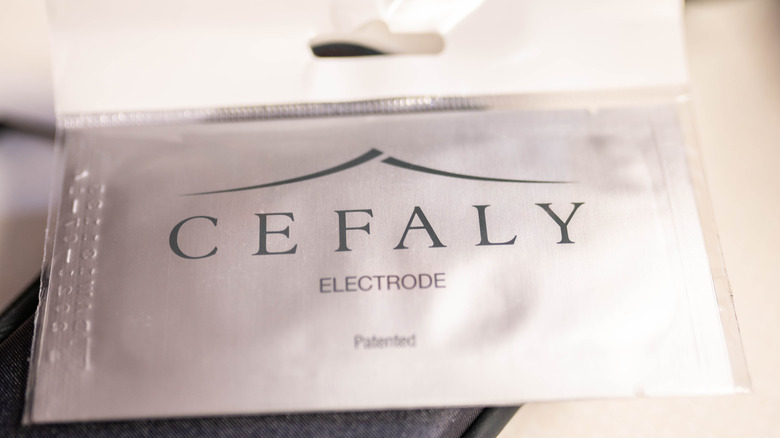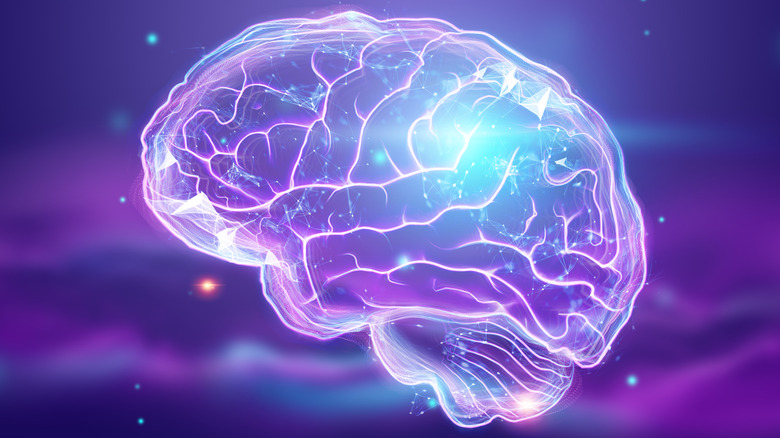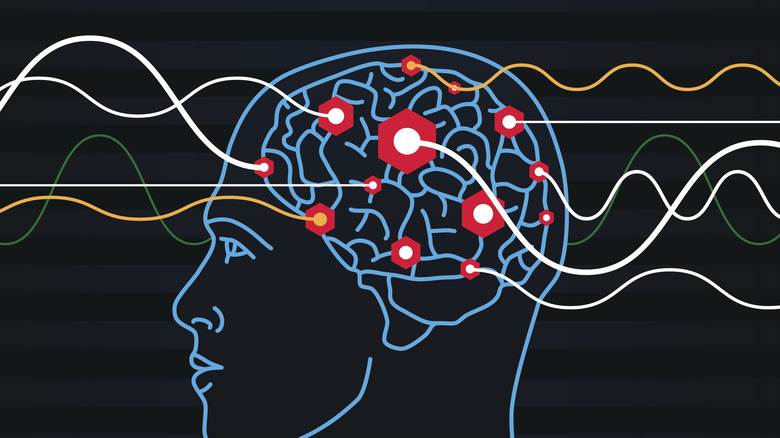Pros And Cons Of Using The Cefaly For Migraine Attacks
If you've ever had a killer headache, you know just how intolerable they can be. This is especially true if you get severe recurrent headaches, also known as migraines (via Mayo Clinic). When migraines take over, any solution sounds like a good one. Enter Cefaly, an FDA approved neurostimulation device that helps target and ease the pain from recurrent migraines, according to the American Migraine Foundation.
Cefaly resembles a headband, designed to be worn across the forehead. The device contains three electrodes that send tiny electrical impulses to your sensory nerves. The theory is that this will stimulate and desensitize the nerves, causing your migraines to reduce over time. This preventative device is advised to be worn for 20 minute daily sessions for two to three months in PREVENT treatment mode (per Cefaly's website). You can also use it in the ACUTE treatment mode for 60 minutes to treat ongoing migraine attacks.
If you are among the 39 million people that suffer from migraines (per Migraine.com), it may be worth giving Cefaly a try. Of course, before you get too excited, it's crucial to inform yourself of the side effects and general effectiveness of Cefaly. Here are all the pros and cons of using this device to treat your migraines.
It targets the primary nerve pathway for migraines
When a migraine attack occurs, there is pressure being put on your brain by swollen blood vessels (via Beyond Exceptional Dentistry). This swelling is triggered by the trigeminal nerve, which releases chemicals that cause blood vessels to swell whenever the nerve is stimulated. The trigeminal nerve starts out at the base of your neck, connecting to the brainstem and branching out to the sides of your face (per Healthgrades). The nerve's position directly correlates to its primary function to monitor sensations in your face, like pain or irritation, and then carry this sensory information back to the brain. Therefore, when the trigeminal nerve is irritated, it sends out pain signals and, in turn, induces migraines, according to Cision PR Newswire.
Cefaly's claim to fame is that it tackles the trigeminal nerve head-on. Since the trigeminal nerve is part of the cranial nerves located in the head, the headband device can easily access it. Cefaly works by sending tiny electrical impulses through the adhesive electrodes located in the headband which stimulate the nerve endings of the trigeminal nerve (per Cefaly's website). According to research published in the journal Pain and Therapy, this stimulation is said to reduce the frequency and intensity of migraines over time.
It's a drug-free treatment option
Let's face it, taking countless prescription drugs when you're sick or suffering from an illness is never fun. In fact, research conducted by the Gallup-Palmer College of Chiropractic Annual Study of Americans in 2017 revealed that 78% of Americans opt for alternative methods to address their physical pain concerns before resorting to pain medications prescribed by a doctor. This rings close to home for migraine treatments, which primarily consist of drugs ranging from over-the-counter painkillers like ibuprofen to strong anti-inflammatories, depending on the severity of your migraines (per WebMD).
Cefaly is a great option for migraine sufferers who don't wish to endure the dreaded side effects that go hand in hand with taking medications. In fact, neurologists have been searching for a drug-free cure to migraines for a long time (via Rowe Neurology Institute). The newly FDA approved device combats frequent headaches without the aid of any drugs. According to the Rowe Neurology Institute, Cefaly also works as a preventative treatment method by eliminating what triggers your migraines. This helps reduce the occurrence of migraines, rather than simply dealing with the pain resulting from them.
The device is easy to use
The good news for prospective consumers of Cefaly is that it is very user-friendly. According to HealthMatch, you'll want to start by washing the skin on your forehead using soap and water. Next, the self-adhesive electrodes should be placed right above your eyebrows. The smallest part of the electrodes should be pointing downwards in the direction of your nose. From here, you can bring the device up to where the electrodes are placed and allow the magnetic attachment to connect the device's rear side to the central part of the electrode.
For the last step, all you have to do is turn on the power and choose the intensity and mode of treatment. You can opt to use the device daily for 20 minutes in the PREVENT setting by pressing the device button twice (via ZiftrShop). If you are experiencing an ongoing migraine, it may be better to use the ACUTE setting for 60 minutes, which can be activated by pressing the device once.
The device's Bluetooth technology also allows you to keep up to date on the progress of your treatment through your phone by downloading CeCe, the device's migraine management app. This allows you to track the intensity of your Cefaly treatments, as well as log in each session's effectiveness. You can even access ready-made reports of your migraine patterns to help you detect when and how often they occur.
The intensity and frequency of your migraine attacks will decrease
Perhaps the biggest selling point for Cefaly is that its advertised capacity to reduce the frequency and intensity of your migraines with continued use. According to research published in the journal Cephalalgia, users suffering from migraine attacks found significant relief after just one hour of Cefaly treatment.
The device's noninvasive technique, alongside how it can be used both during the onset of migraines and for preventing them, makes it a cutting edge tool. In fact, for people suffering from migraines, the prevention feature of the device is specifically what makes it a top choice to treat their chronic headaches. This is because people with migraines can experience symptoms of throbbing pain, nausea, vomiting, and sensitivity to light and sound for anywhere between 4 to 72 hours, per findings published in the JAMA Network. Coupled with the fact that these migraines can return several times a month, you can only imagine how uncomfortable this experience might be for migraine sufferers.
Cefaly hones in on this suffering by treating the root cause of migraine pain in order to prevent symptoms and ease pain over time. However, it's important to note that results can vary depending on the intensity and nature of your migraines (via Cefaly).
It's not suitable for everyone
Unfortunately, Cefaly is not the right treatment choice for everyone. This first-of-its-kind device is only suitable for patients 18 years or older that suffer from episodic migraines, per Healthline. Users of the device should also not have any metallic or electronic devices implanted in their head, or have a cardiac pacemaker or defibrillator, according to the FDA.
Since the device is reserved for sufferers of chronic migraine attacks, Cefaly is intended for users that suffer from at least three migraines per month and need help to bring it under control (via the Migraine Relief Center). If you are experiencing pain but don't know the cause or have not been diagnosed with a migraine condition, it is best to check with your doctor before using Cefaly.
The same is applicable if you are pregnant, are above 65 years in age, have a history of seizures, or had a recent head injury (via GoodRx Health). In addition, due to the device's neurostimulation qualities, it should only be applied and used in the forehead region.
You might not notice results for a while
If you're a new Cefaly user, you may want to give yourself a little bit of time to adjust to the new device before throwing in the towel. This is because, on average, Cefaly claims to take at least two months to show results (per Migraine.com). This varies from person to person, though, as some people may see improvements as early as a few weeks, while others may take a few months.
If you are hoping to experience immediate results from Cefaly, then the treatment might not be the best method for you. However, if you believe that you would benefit from the long-term gains of the device, then Cefaly may be a more appropriate treatment option. In fact, research published in the journal Pain and Therapy has shown that Cefaly has proven to be effective in the long run, with participants spotting a significant decline in the number of migraines they experienced by month three of treatment.
The good news is that Cefaly comes with a 60-day money-back guarantee, so if you invest in Cefaly and are not seeing the results you hoped for, you could get your money back. The devices also come with a two-year defective warranty in order to ensure that your device stays in good working condition (via OZHealth Pharma).
The treatment can get costly
Cefaly may be an effective treatment option, but it is certainly not cheap. The device costs $389 to purchase. In addition, the three electrodes in the headband device need to be replaced every 90 days, costing an additional $25 to $33 each time (per The Migraine Nurse).
With that said, there are a few different options to help make financing it easier. Cefaly has partnered with Affirm and Paypal Credit to offer the option of paying for the device in installments (via Cefaly). For Paypal Credit, you can pay in six equal monthly installments without interest, while Affirm gives you the option of starting at $30 per month, but interest rates may apply. While these payment plans can help lower the cost of the device, Cefaly is typically not covered by insurance, per The Daily Headache. However, if you have a Health Savings Account or a Flexible Spending Account, you can use it to help you pay for the device (per Cefaly).
Ultimately, if you frequently experience intense headaches and are looking for an alternative method to medication, it may be worthwhile to invest in Cefaly.
You might find the electrostimulation uncomfortable
Electrostimulation is a way to help stimulate the nerves in order to ease pain by passing mild electrical pulses or currents (via Healthline). Cefaly utilizes this electrostimulation technique to pass tiny currents to stimulate the trigeminal nerve, thereby stopping activity within the nerve that would otherwise signal pain to the brain (per Barrow Neurological Institute).
According to The Daily Headache, the experience of using Cefaly is akin to "a mild buzzing sensation with a sharpness to it that's not quite pins-and-needles." As the device's intensity gradually increases during the treatment, so does this tingling and buzzing sensation. However, it does give you the option to adjust the intensity if you start to feel uncomfortable.
Some negative reviews indicate that some people have felt uncomfortable using Cefaly, per Medical News Today. If you do decide to invest in Cefaly and endure the uncomfortable sensation for long-term results, be sure to stop your session if the device starts to hurt. Additionally, if a stinging sensation occurs for any reason, it may be because you have a small scrape or cut or the electrode is not sticking correctly to your forehead (via Cefaly). In this case, hypoallergenic blue gel electrodes are also available for use.
It can trigger headaches
It may seem counterintuitive that a device meant to prevent headaches causes them. However, one downside to using Cefaly is that it can actually trigger headaches. Specifically, individuals have reported experiencing headaches after using the device in PREVENT mode (per Medical News Today).
The reason for headaches occurring as a side effect of Cefaly is largely due to the neurostimulation effect of the device. Neurostimulation can often cause a "pins-and-needles" or tingling sensation in many users, which can cause some individuals to have a headache directly after using the device (via research published in Scientific Reports). With that said, similar to how there is an adjustment period with any medication, the side effects of this device will likely become less bothersome over time. But if the sound of a treatment-induced headache is something you would rather avoid, then it may be better to not take your chances with Cefaly.
You may get sleepy post-treatment
You know how migraines can make it hard for you to fall or stay asleep? Well, the opposite might be true after receiving Cefaly treatments. Sleepiness is reported to be one of the most common side effects of using the device (per Migraine.com).
In a study published in The Journal of Headache and Pain, out of 2,313 migraine sufferers who rented Cefaly for a 40-day trial period, 19 participants complained of sleepiness and fatigue. Due to sleepiness being an observed side effect, all users are advised to not operate heavy machinery, drive, or do any activity that can put you at risk while utilizing the device.
In addition, even though sleepiness can very well occur while using Cefaly, utilizing it while sleeping is a major no-no (per Cefaly.com). Though the device will shut off after the allotted treatment time, damage can occur to the electrodes or the device itself while you sleep (via MigrainePal).
Redness or skin allergies can occur
A potential downside to using Cefaly is an increased chance of redness or skin allergies. Skin tingling, burning, and itchiness are fairly common in various transcranial electrical stimulation techniques, per research published in the journal Brain Stimulation.
Cefaly's use of adhesives to apply electrodes can also cause the skin to be irritated. Your skin may appear blotchy or red immediately after using Cefaly (per Cefaly's website). Research has shown that some users experience rashes post-Cefaly, which may be due to an electrode gel allergy (via The Journal of Headache and Pain). However, this should disappear shortly after treatment. If the rash does not disappear, it is best to contact the manufacturers or a doctor for advice.
Additionally, migraine sufferers with allodynia — a condition in which even light touch can be painful (via American Headache Society) — can also be overwhelmed by the device's electrodes touching or pressing down on their foreheads. Lastly, if you have any open wounds, cuts, or other skin irritations, it may be best to avoid using the device.
You could get dizzy or nauseous
Fatigue, nausea, and dizziness often go hand in hand with the painful migraines that we experience. In fact, nausea can be a key factor in determining that an individual is indeed suffering from migraines, as it occurs in about 58% of people experiencing a migraine, according to Self. Unfortunately, dizziness and nausea are also among the less likely but nevertheless potential side effects of Cefaly, per Medical News Today.
Nausea and dizziness tend to manifest when using the device in preventative mode. In addition, complaints of nausea typically come up early on in the treatment process, with users reportedly experiencing some mild discomfort (via MigrainePal). However, these potential side effects are typically minimal in both intensity and frequency, and eventually disappear over the course of treatment.
Positive reviews also indicate that Cefaly has helped eliminate nausea along with migraines for some users in the long run (per PatientsLikeMe).
Your migraines could return
Cefaly's goal is to desensitize the trigeminal nerve gradually in order to prevent headaches from occurring (per Cision PR Newswire). But how successful is Cefaly in actually accomplishing this objective? According to Healthline, Cefaly's long-term effectiveness remains unknown. This means that theoretically, your migraines could return after treatment.
If your migraines do return, there are a few different ways you can attempt to combat or minimize them. According to Mayo Clinic, establishing a regular sleep schedule, keeping a journal to track your triggers, maintaining a healthy diet, and regularly exercising can all equip you to better combat your migraines. In addition, it could be beneficial to determine if your migraine trigger is physical (e.g., dehydration, lack of sleep) or emotional (e.g., stress, anxiety), per WebMD.
Overall, while Cefaly has been given the green light by the FDA as a promising alternative migraine treatment, it may not be suitable for everyone. However, if you're capable of enduring its known side effects for a chance to keep your migraine at bay, then Cefaly may be worth a try.














